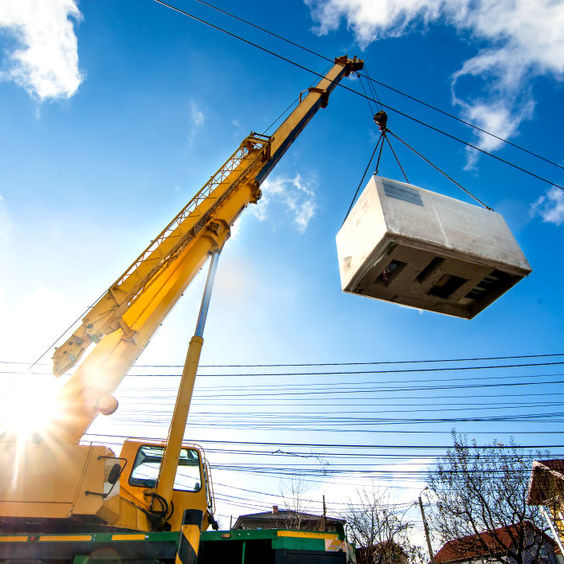16.F Testing.
16.F.01 Written reports of tests, showing test procedures and confirming the adequacy of repairs or alterations, must be maintained with the crane and hoisting equipment or at the on-site project office.
16.F.02 Operational Testing.
- A QP must conduct operational tests in accordance with ANSI/ASME and the manufacturer's recommendations. If the manufacturer has no procedures, the requirements in this Section, as a minimum, must be performed.
- Operational testing must be performed:
(1) Before initial use of a crane or hoisting equipment after a load bearing or load controlling part or component, brake, travel component, or clutch (to include securing devices, skids and barges for floating cranes) has been altered, replaced, or repaired.
Note: Adding/removing counterweights is not considered load controlling/load bearing.
- (2) Every time a crane or hoisting equipment(s) is reconfigured or re-assembled after disassembly (to include booms);
- (3) Every time a crane and/or hoisting equipment is brought onto a USACE project; and
(4) Every year during annual inspection.
Note: Complete operational testing of the equipment after the replacement of wire rope is not required. However, a limited operational test must be made prior to putting the equipment back into service.
- Operational Testing, as a minimum, must include the following:
- (1) Load lifting and lowering mechanisms;
- (2) Boom lifting and lowering mechanisms;
- (3) Boom extension and retraction mechanisms;
- (4) Swinging mechanisms;
- (5) Travel mechanisms;
- (6) Safety devices;
- (7) Operational aids.
16.F.03 Load Testing.
Load testing is considered a Critical Lift. > See Section 16.H.
- Load tests must be performed under the direction of a QP in accordance with appropriate ASME standards and the manufacturer's recommendations. At a minimum, the load test procedures must include the following:
- (1) Hoist the test load to ensure that the load is supported by the crane and held by the hoist brake(s) for a minimum of 5 minutes;
- (2) Swing the crane. Insure there are no physical restrictions, the full range of its swing, with the test load;
- (3) Boom the crane up and down within the allowable working radius for the test load. At the maximum radius, hold the load for a minimum of 5 minutes and insure there is no movement of the load;
(4) Lower the test load and hold the load with the brake(s).
Note: If the manufacturer is no longer in business and procedures are unavailable, a QP familiar with the type of equipment involved must develop and approve procedures, which as a minimum, must include those listed above.
- Load Testing must be performed at 100 to 110% of the ANTICIPATED LOAD for the specified configuration, not to exceed 100% of the manufacturer's load chart at the configuration of the test. The actual anticipated load itself may be used as the test load if approved by the GDA.
- Load testing must be performed:
-
(1) Before initial use of crane or hoisting equipment in which a load bearing or load controlling part or component, brake, travel component, or clutch has been altered, replaced, or repaired, and
Note: Adding/removing counterweights is not considered load controlling/load bearing.
(2)Every time a crane or hoisting equipment(s) is reconfigured or re-assembled after disassembly (to include booms);
Note: Attaching/detaching a jib, which is an attachment, is not considered "reconfiguring or re-assembling" a crane and so does not require a load test. Installing or stowing the jib must be per manufacturer's recommendations and a competent person must document this action prior to operation.
- (3) When the manufacturer requires load testing.
- (a) The employer must specifically research, identify and document manufacturer required load-testing frequency for each USACE-owned/operated and/or Contractor- owned/operated crane or hoisting equipment and maintain and/or provide this information to the GDA;
- (b) Under conditions (1) and (2) above, a selective load test may be performed (testing only those components that have or may have been affected by the alteration, replacement, or repaired);
- (c) The replacement of the rope is specifically excluded from this requirement. However, a limited operational test including actions in Sections 16.F.02.c above, under a normal operating load must be made prior to putting the equipment back into service.
- The manufacturer's specifications and limitations applicable to the operation of any crane and hoisting equipment must be followed. At no time must a crane or hoisting equipment be loaded in excess of the manufacturer's rating, except overhead and gantry cranes in accordance with ANSI/ASME B30.2 or B30.16. Loads must not exceed 125% of the rated load for test purposes or planned engineered lifts for overhead and gantry cranes.> See Section 16.H, Critical Lifts.
- (1) Where manufacturer's specifications are not available, the limitations assigned to the equipment must be based on the determinations of a registered engineer competent in this field, and such determinations will be documented and recorded.
- (2) Attachments used with crane and hoisting equipment must not exceed the capacity, rating, or scope recommended by the manufacturer.
- Written reports that show test procedures and confirm the adequacy of repairs or alterations must be maintained and provided upon request.
Knowledge Check Choose the best answer for the question.
16-8. Load Testing must be performed at _____ of the ANTICIPATED LOAD for the specified configuration.
You forgot to answer the question!

